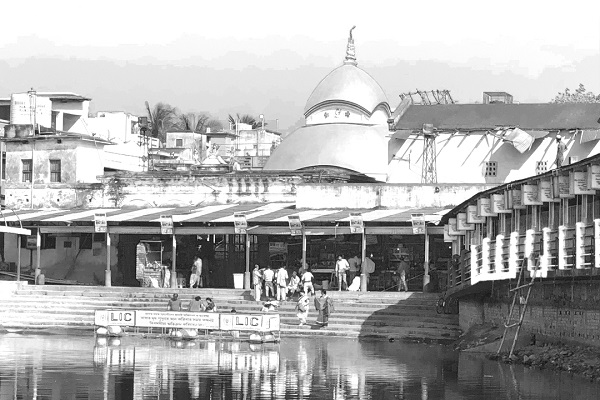Exploring the Divine Serenity of Tarakeswar Temple

Welcome to a spiritual journey that will take you to the sacred grounds of Tarakeswar Temple, also known as Babar Dham. Nestled in the serene town of Tarakeswar in West Bengal, India, this temple holds immense historical and religious significance, attracting millions of devotees and tourists every year.
The Legend and History
Tarakeswar Temple holds a captivating mythological story that dates back centuries. According to legend, the temple is associated with the great Hindu god Lord Shiva, who assumed the form of "Taraka Brahma" to vanquish evil forces. The temple was built in 1729 by Raja Bharamalla, the then ruler of Bengal.
Architectural Marvels
The main temple structure showcases a unique blend of traditional Bengali and Mughal architectural styles. With its towering spires, intricate carvings, and ornate sculptures, the temple is a testament to the exquisite craftsmanship of ancient artisans.
Religious Significance and Festivals
Tarakeswar Temple is a significant religious destination for devotees of Lord Shiva. The temple is renowned for its festivals, especially the Tarakeswar Mela, held during the holy month of Shravan. Devotees undertake the Kanwariya Yatra, a month-long pilgrimage to fetch holy water from the nearby Ganges River and offer it to Lord Shiva at the temple.
Spiritual Bliss and Serene Surroundings
Aside from its religious significance, Tarakeswar Temple offers a tranquil atmosphere that provides solace to the weary soul. The temple's serene surroundings, including lush greenery, manicured gardens, and a sacred pond, create the perfect environment for meditation and introspection.
Plan Your Visit
To experience the divine embrace of Tarakeswar Temple, plan your visit to this mystical realm. It is located approximately 58 kilometers away from Kolkata, and can be easily reached by various transportation options.
Tarakeswar Mandir Timing
Lord Shiva is awakened and bathed daily by nine every morning. The daily puja is then finished at half-past ten o'clock in the morning. The worshippers can then enter the temple. From 10:30 to 11:30 a.m., Maharaja Puja is performed. The gathering of worshippers then resumed. Lord Shiva sleeps for the day in the afternoon. The worshippers can then come to the temple from the afternoon till the evening. Sandhya Aarti is performed at this hour, and the temple shuts at 8:30 PM. You may all visit the Tarakeswar temple for puja if you follow these tentative Tarakeswar temple timings.
Frequently Asked Questions (FAQ) - Tarakeswar Temple
1. What is Tarakeswar Temple?
Tarakeswar Temple is one of the most famous Hindu mandirs in India. The temple enshrines a Shiva linga. It was built in 1729 by Raja Bharamalla in Tarakeshwar city of Hooghly District and features an "atchala" (or the double-storey at-chala type with eight roof corners) and "natmandir" (or palace temple).
2. When was Tarakeswar Temple built?
Tarakeswar Temple was built in 1729 by Raja Bharamalla.
3. Why is Tarakeswar Temple renowned as "Babr Dham" or "The City of Shiva"?
Tarakeswar is very renowned as "Babr Dham" or "The City of Shiva" due to the presence of the Tarakeswar Temple and its significance as a major pilgrimage site for Lord Shiva devotees.
4. What is the significance of Chaitra Mela and Sravani Mela at Tarakeswar Temple?
Every year during Chaitra Mela and Sravani Mela, lakhs of worshippers visit the temple. These festivals are a time of great religious fervor and devotion.
5. How do worshippers reach Tarakeswar Temple during the festivals?
Worshippers first collect water from the Ganges, mostly from Sheorafuli. They carry the water using a "Baank," which is a bamboo stick with two pots full of the Ganges' water, tied with ropes. Also, both the pots are sealed with "Ganga Mati." Then they travel from Sheorafuli to Tarakeswar carrying the Baank on their shoulders by walking with bare feet. The distance between Sheorafuli to Tarakeswar is nearly 37.4 km. After reaching Tarakeswar, they dedicate the water on the head of Lord Shiva inside the Mandir.
6. Is Tarakeswar Temple popular among international visitors?
Yes, people come to Tarakeswar Temple from all across the globe. Small children to old ages are often found among the worshippers. It is a place of spiritual significance for people worldwide.
7. What should one do if someone gets lost during Sravani Mela?
If someone is lost during Sravani Mela, immediate assistance can be sought by sending messages to https://www.facebook.com/tarakeswardotin. Help can also be obtained from Tarakeswar Temple, Tarakeswar Police Station, and Tarakeswar Municipality.
8. What is the significance of the pond at Tarakeswar Temple?
The pond of Tarakeswar Temple is famous as "Dudh Pukur." The pilgrims are allowed to bathe in Dudh Pukur only within a safe range before entering the Temple for Puja (A virtual form of "Dudh Pukur" could be experienced in https://tarakeswar.in).
9. Are there other temples within the premises of Tarakeswar Temple?
Yes, besides Tarakeswar Temple, there are other temples within the premises, including the Kali Temple, Narayana Temple, and other temples. These temples add to the religious and spiritual ambiance of the place.
10. Can a virtual experience of "Dudh Pukur" be accessed online?
Yes, a virtual form of "Dudh Pukur" can be experienced on the website of Tarakeswar.in (https://tarakeswar.in). It offers a virtual experience of the sacred touch in Dudh Pukur.